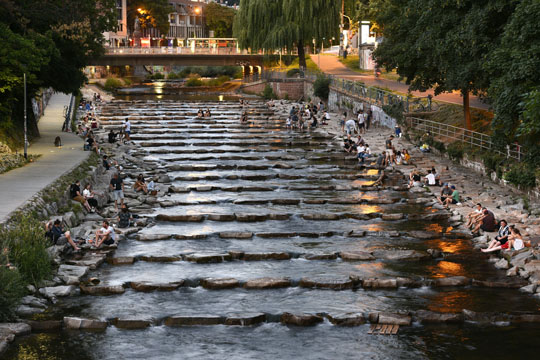Water shortages lead to heightened conflicts
Freiburg, Aug 04, 2020
The project's acronym says it all: In the "DRIeR" project, researchers from Freiburg, in cooperation with other partners, have investigated the effects of drought and aridity in Baden-Württemberg. DRIeR is a good example of successful interdisciplinary cooperation, said Kerstin Stahl, Professor of Environmental Hydrological Systems at the University of Freiburg. She heads the project together with her colleague Prof. Dr. Jens Lange, also a hydrologist. In celebration of the 50th anniversary of the Faculty of Environment and Natural Resources (UNR), a series of different research projects and departments will be presented. The fourth part - "Water" - deals with recently developed recommendations for the management and use of water.
 The fish ladders in Freiburg are a popular spot when temperatures rise. In really hot summers the water level of the Dreisam drops drastically.
The fish ladders in Freiburg are a popular spot when temperatures rise. In really hot summers the water level of the Dreisam drops drastically.
Photo: Thomas Kunz
"For a long time, the public and researchers focused more on floods as extreme weather events than drought and aridity," says Kerstin Stahl. Together with scientists from the Universities of Tübingen, Heidelberg and Freiburg, she wanted to focus more on this “forgotten extreme,” investigate its consequences for the State of Baden-Württemberg and use the results to derive recommendations for affected regions. In 2015, the group submitted its proposal for the project “DRIeR: Drought impacts, processes and resilience: making the invisible visible” to the State Ministry of Baden-Württemberg for Science, Research and the Arts (MWK) - in the same year that a severe drought led to dried-out soil, harvest losses and low water throughout Germany. “At that time, the media increasingly reported on the effects of drought, and our project took on a new meaning,” recalls the hydrologist.
Today, DRIeR unites eight chairs covering disciplines in the humanities, natural sciences and law. From the UNR Faculty, the Chairs of Environmental Hydrological Systems, Forest and Environmental Policy, Hydrology, Silviculture and Physical Geography are involved. DRIeR also works closely with partners from politics and practice, including water and environmental authorities, industry associations, the State Institute for the Environment Baden-Württemberg, Forst Baden-Württemberg, the Agricultural Technology Centre Augustenberg and the MWK, which is funding the project with two million euros.
Speaking with stakeholders
To answer central research questions, the departments used different methods: Stahl and her team analyzed water flows based on monitoring data and measured the nitrate content in groundwater to analyze the quantity and quality of the resources available for drinking water supply. In field experiments with dry roofs, vegetation ecologists simulated the effects of severe droughts on grass ecosystems and investigated their resilience. Lawyers examined the legal options for water management and compared them with laws from countries such as California and Spain, which are regularly affected by droughts.
Discussions and workshops with various stakeholders, including, for example, hydroelectric power plants, agriculture and forestry, and federal and state policymakers, provided information on lines of conflict between the affected sectors and actors. The researchers also found out what demands or offers of help for resilience strategies the different groups had. In addition, DRIeR evaluated media reports and scientific publications in order to understand the changes in drought impacts. Among other things, the team analyzed the political framework for dealing with drought impacts since the beginning of the 20th century and the influence of global warming in recent decades.
More frequent summer droughts ahead
The project will end in autumn 2020. At that time, the researchers want to present a conceptual model that shows the connection between the causes and effects of droughts and aridities and makes recommendations for the management and use of water. Stahl will report some basic results in advance: Firstly, the chains of effects developed have hardly changed over time - today, as then, droughts have a direct influence on water, electricity and food supplies. Secondly, the vegetation projects show that grass ecosystems are robust and can recover relatively quickly from the effects of drought - although these findings cannot be transferred to the forest sector. Furthermore, the legal comparisons clearly show the lack of uniform nationwide regulations on water law issues.
“The processes are closely interlinked. Without clear regulations, this situation will exacerbate existing usage conflicts,” says Stahl. There is an urgent need for cross-sectoral water management, especially since forecast models indicate more frequent drought summers in the future. “Politicians must clarify which sectors have priority access to water in times of shortage. In my view, the top priority is the drinking water supply,” stresses the hydrologist. But what happens, for example, if too much drinking water is taken and the groundwater level drops? This scenario increases the challenges for forest owners and farmers, who have to supply animals and plants with the limited resources. At the same time, certain industries - and thus jobs in the region - can only maintain their production if they have sufficient cooling water. “The regional prioritization of sectors is usually preceded by a long process of understanding and negotiating among all stakeholders.”
Kerstin Stahl is certain that not only those affected, politicians and specialist authorities in Baden-Württemberg will benefit from the project results. The findings are also transferable to other German regions. “We know that our results to date have already been incorporated into other information and forecasting platforms. These include a program addressing droughts in the Alpine region,” Stahl explained. “In that way, we have achieved our goal of making the invisible visible.”
Kristin Schwarz
More articles from this series:

